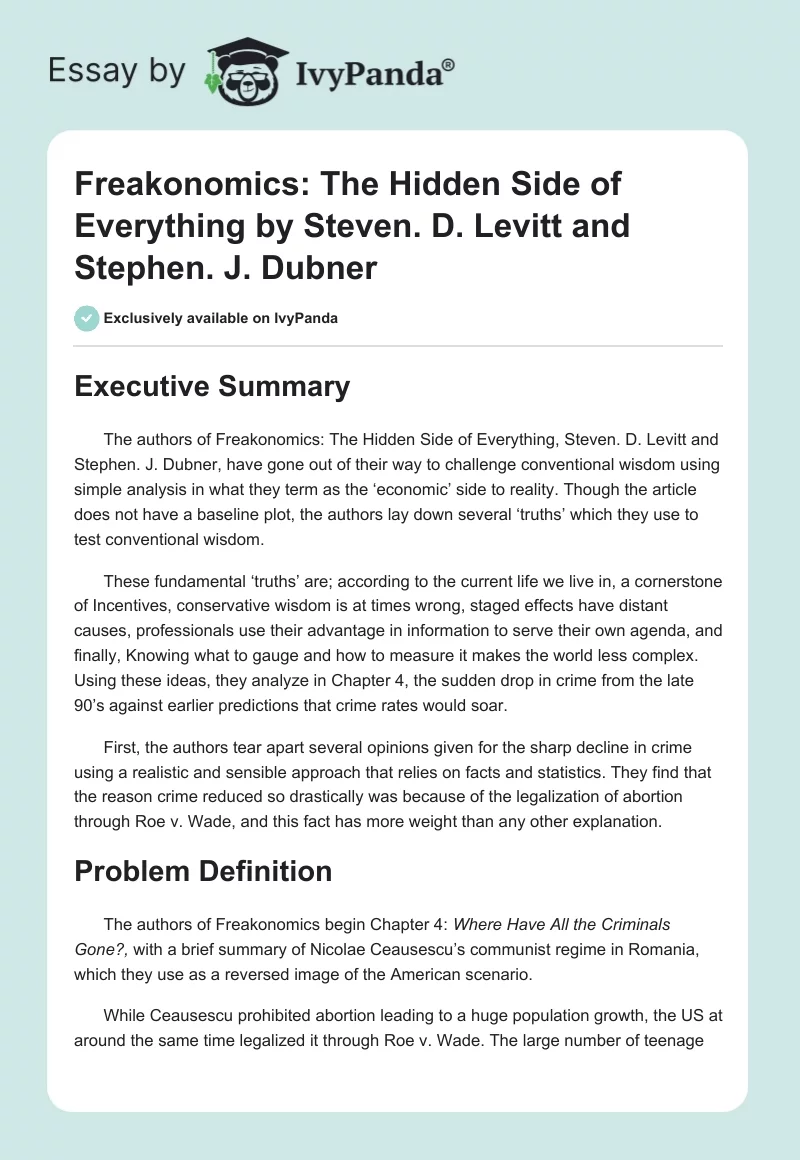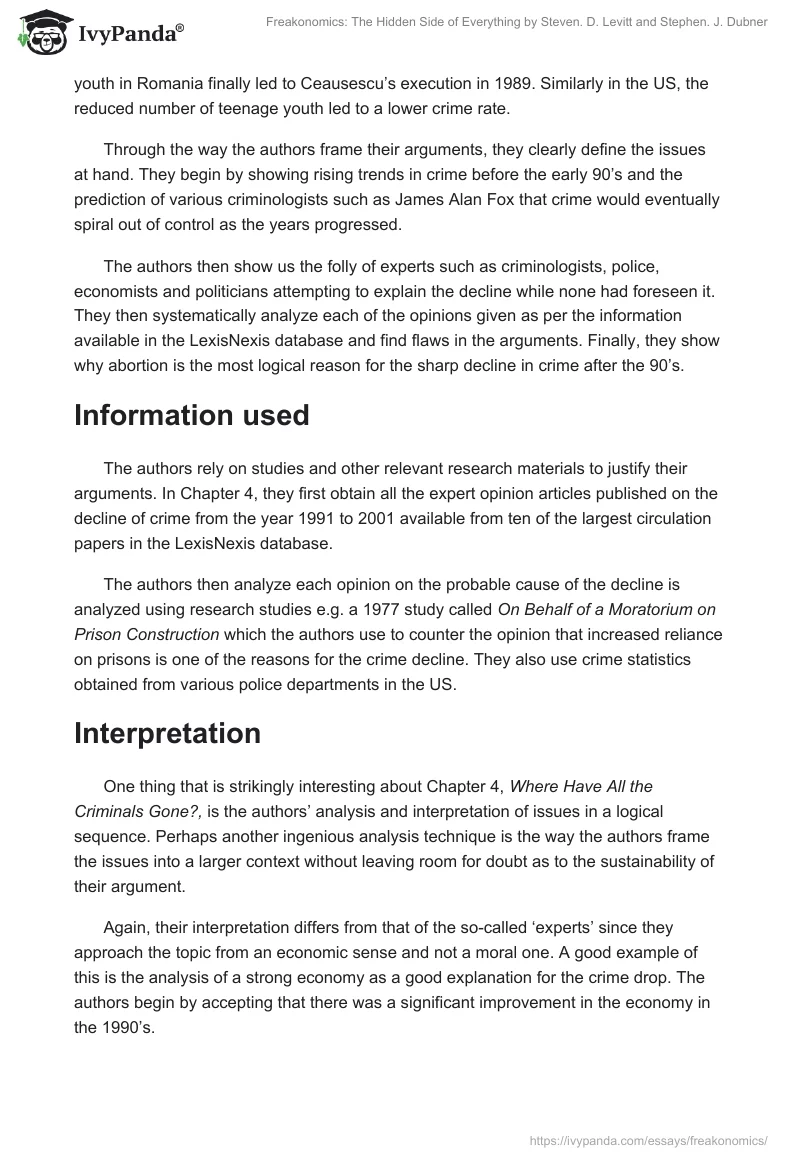Executive Summary
The authors of Freakonomics: The Hidden Side of Everything, Steven. D. Levitt and Stephen. J. Dubner, have gone out of their way to challenge conventional wisdom using simple analysis in what they term as the ‘economic’ side to reality. Though the article does not have a baseline plot, the authors lay down several ‘truths’ which they use to test conventional wisdom.
These fundamental ‘truths’ are; according to the current life we live in, a cornerstone of Incentives, conservative wisdom is at times wrong, staged effects have distant causes, professionals use their advantage in information to serve their own agenda, and finally, Knowing what to gauge and how to measure it makes the world less complex. Using these ideas, they analyze in Chapter 4, the sudden drop in crime from the late 90’s against earlier predictions that crime rates would soar.
First, the authors tear apart several opinions given for the sharp decline in crime using a realistic and sensible approach that relies on facts and statistics. They find that the reason crime reduced so drastically was because of the legalization of abortion through Roe v. Wade, and this fact has more weight than any other explanation.
Problem Definition
The authors of Freakonomics begin Chapter 4: Where Have All the Criminals Gone?, with a brief summary of Nicolae Ceausescu’s communist regime in Romania, which they use as a reversed image of the American scenario.
While Ceausescu prohibited abortion leading to a huge population growth, the US at around the same time legalized it through Roe v. Wade. The large number of teenage youth in Romania finally led to Ceausescu’s execution in 1989. Similarly in the US, the reduced number of teenage youth led to a lower crime rate.
Through the way the authors frame their arguments, they clearly define the issues at hand. They begin by showing rising trends in crime before the early 90’s and the prediction of various criminologists such as James Alan Fox that crime would eventually spiral out of control as the years progressed.
The authors then show us the folly of experts such as criminologists, police, economists and politicians attempting to explain the decline while none had foreseen it. They then systematically analyze each of the opinions given as per the information available in the LexisNexis database and find flaws in the arguments. Finally, they show why abortion is the most logical reason for the sharp decline in crime after the 90’s.
Information used
The authors rely on studies and other relevant research materials to justify their arguments. In Chapter 4, they first obtain all the expert opinion articles published on the decline of crime from the year 1991 to 2001 available from ten of the largest circulation papers in the LexisNexis database.
The authors then analyze each opinion on the probable cause of the decline is analyzed using research studies e.g. a 1977 study called On Behalf of a Moratorium on Prison Construction which the authors use to counter the opinion that increased reliance on prisons is one of the reasons for the crime decline. They also use crime statistics obtained from various police departments in the US.
Interpretation
One thing that is strikingly interesting about Chapter 4, Where Have All the Criminals Gone?, is the authors’ analysis and interpretation of issues in a logical sequence. Perhaps another ingenious analysis technique is the way the authors frame the issues into a larger context without leaving room for doubt as to the sustainability of their argument.
Again, their interpretation differs from that of the so-called ‘experts’ since they approach the topic from an economic sense and not a moral one. A good example of this is the analysis of a strong economy as a good explanation for the crime drop. The authors begin by accepting that there was a significant improvement in the economy in the 1990’s.
They first show that this rationale only applies for non-violent crimes, which is true. Secondly, they rely on studies to show that a drop in unemployment rates reduces non-violent crime by a mere 1%. They kill off the rationale by comparing the scenario to the 1960’s where the economy grew at the same rate as crime.
The analysis of the impact of Roe v. Wade and how it led to a lower crime rate separates the authors’ interpretations of the issues from those of the experts. They first take statistics of the number of abortions carried out after Roe v. Wade and the impact this had in terms of lowering abortion costs, preventing unwanted children who would most likely have turned into criminals and finally, the link between causality and correlation in the issue of crime and abortion.
While other experts have preferred ‘positive’ and easily explainable explanations such as better policing and stricter gun control laws, the authors have diverted from this appealing ‘moral’ view to a more realistic solution.
Conclusion
Freakonomics is well researched and analyzed but has some flaws such as its disregard of positive crime reducing measures. While the authors have ‘expertly’ analyzed the drop in crime using economic realities, they agree that the other opinions are not too far fetched.
They also do not state that the decline was as a consequence of one act, but instead, they seek to establish the most logical explanation. Their finding of the legalization of abortion as being a major cause of the crime drop though vexatious to many is shockingly accurate, judging on the convergence of statistics and the support by facts such as the corresponding years between the US and Romanian cases.


